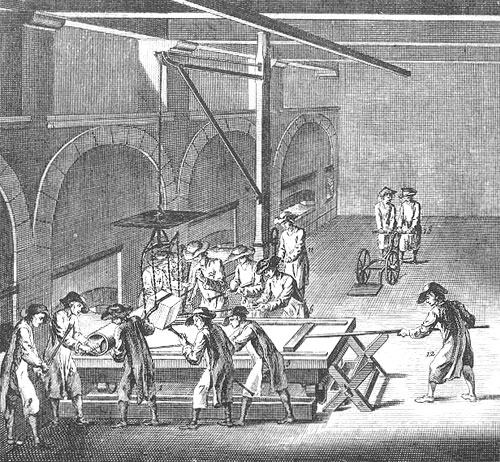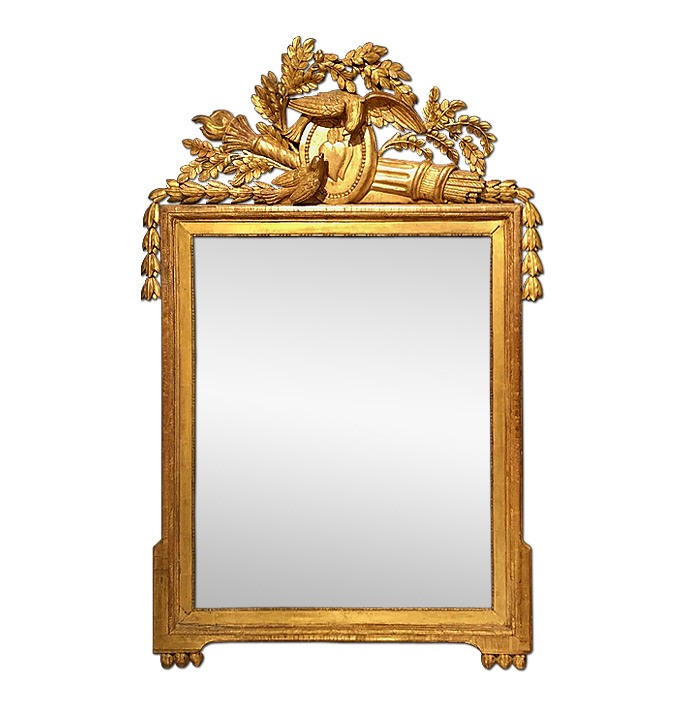HISTORY
THE MIRROR IN EUROPE
Venice mirror, end of the 17th century. Polychrome painted cut glass with a pediment.
Illustration – Not for sale
In Venice, in the island of Murano, the master glassmakers in their workshops develop the techniques of blown glass, crystal and pressed glass. The making of ice in the Venetian glassware of Murano opens up new possibilities for the use of the mirror, especially in decoration. The Venetians keep the manufacturing secret and the exclusivity of production until the 17th century. Murano glassmakers export their works to the rest of Europe, influencing the artistic character of the production.
At that time the first frames of mirrors were simple wooden frames, poplar, chestnut, and walnut. Little by little, the mirrors adapt to the Gothic and then Renaissance spirit. The frames become more massive with small columns, pediments, ornamentation of mythological figures, pearls and acanthus leaves. There are also goldsmiths mirrors adorned with precious stones and bronzes. The most famous mirror of the period is the so-called “Marie de Medicis” mirror purchased by Louis XIV in 1684.
During the 17th century, mirror manufactures appeared in other European countries, calling on the expertise of Venetian glass masters.
Venetian mirror named “Marie de Médicis”, circa 1630. Frame: Agate, onyx, gray jasper, cameos in sardony, rubies, diamonds, 3 emeralds, garnets or enamel and 18 cameos.
Illustration – Not for sale
THE MIRROR IN FRANCE
In France at the beginning of the 17th century, under the reign of Louis XIII, glass factories began to open, competing or complementary, state or private, in Saint-Gobain in Picardy, in Tourlaville near Cherbourg, in Lézinnes in Bourgogne and Montmirail in Champagne.
17th Century
In 1665 King Louis XIV created with his minister Colbert the Royal Manufacture of mirrors, rue du Faubourg Saint Antoine in Paris, to compete with the glassmakers of Venice. Over time, the Venetian monopoly is replaced by the French monopoly.
King Louis XIV (1638-1715) gave his support to all artistic creation. He was passionate about the arts as much from personal taste as from political sense. Under his reign, the mirror has taken an important place in interior decoration, the shapes and frames with symmetrical lines are adapted to the furnitures style. Gilded woods, inlays and lacquers are created by renowned decorators and ornamentalists.
The method of manufacturing the glass mirror is perfected. The French master glassmaker, Bernard Perrot (1638-1709), invented a new method for pouring flat glass on the table. This new technique allows the manufacture of large-scale mirrors, used for interior decoration such as the Hercules gallery at the Lambert Hotel in Paris and the famous Hall of Mirrors in Versailles. It was at this time that the distorting, elliptical, pyramidal mirrors appeared.
Louis XIV period mirror. Gilded carved wood, glass mirror and “verre églomisé” (French: “Glomyized glass”). The method owes its name to Jean-Baptiste Glomy (d. 1786), a French picture framer who used the process in glass mounts..
Illustration – Not for sale
The Hall of Mirrors – Palace of Versailles, (1678-1684)
During the reign of King Louis XIV, the Palace of Versailles and the Hall of Mirrors designed and built from 1678 to 1684 by architect Jules Hardouin-Mansart was then intended to illustrate the power of the absolute monarch and to dazzle its visitors. The gallery, unheard of at the time, is covered with 357 mirrors, richly adorned with decorations painted by the painter Charles Le Brun.
At the same time, the style of André-Charles Boulle (1642-1732) cabinetmaker of King Louis XIV enjoyed great popularity. He was the first in his time to apply gilded bronze to cabinetmaking. The mirrors are made of precious wood, tortoiseshell, mother-of-pearl and brass.
There are also chinoiseries with mirrors in lacquer or Martin varnish inspired by the Far East, adorned with pagodas, exotic plants… In parallel with the Louis XIV style, the Rococo style with curved and asymmetrical shapes is developing throughout Europe.
Table mirror from the 17th century, André-Charles Boulle style. Tortoise shell, engraved brass, violet wood, amaranth, satin wood, ebony wood, bronze.
Illustration – Not for sale
18th Century
During the 18th century, the style of King Louis XV supplanted the classicism, considered too formal, which marked the reign of Louis XIV. The mirrors are made for the decoration of royal and aristocratic residences.
The Louis XV style known as the Rocaille style is one of the sources of Rococo, but exceptionally in the rest of Europe it is expressed almost exclusively in the decorative arts to the detriment of architecture. The frame of Louis XV mirrors is asymmetrical, adorned with eventful decorations, embellished with shells and plants. Mirrors in gilded wood but also precious woods from India such as ebony, violet wood, rosewood…
Over time, all of Europe evolved from the baroque and massive style of golden frames to lighter ornamentation. In particular, at the start of the 18th century, the stylistic influence of the French ornamentalist Daniel Marot (1661 – 1752) in Holland, then in London, should be noted.
Under the reign of Louis XVI (1754 – 1793), the archaeological discoveries of the excavations of Herculaneum (1709) and Pompeii (1748) mark a return to an ancient sobriety in the Greco-Roman style. The Louis XVI style mirror is characterized by straight lines and symmetry of the ornaments.
19th Century
Empire mirror, mahogany wood and bronze.
Illustration – Not for sale
From 1804 to 1815, Emperor Napoleon I (1769-1821) marked his reign with an official decorative style. The Empire style will prevail throughout Europe with its military victories and political expansion.
The ornamentations of Empire furniture are inspired by Greco-Latin and Egyptian antiquity, following Napoleon’s military campaigns in Egypt from 1798 to 1801.
The Empire period mirrors are primed and gilded with fine gold with ornaments of great finesse, antique patterns, oves, caryatids, palmettes… They are also in light mahogany wood, moire and dark or mahogany veneer with chiseled bronzes. Large-sized mirrors make it possible to manufacture psyche mirrors, fireplace mirrors, in-between mirrors.
Empire Psyche mirror in mahogany veneer and bronze.
Illustration – Not for sale
With the fall of the empire in 1814, royalty returned to power. The Restoration is the name given to the political regime of France between 1814 and 1830. It refers to the return of the kings of the Bourbon dynasty after the period of the French Revolution and the First Empire.
The Restauration style is a “neo-classicizing” style, inspired by the old monarchy and English cabinetmaking, a more sinuous, more feminine style and less severe. The gilded or silvered woods have ornamentations with smaller and rounder palmettes than that under the Empire style, just as the other motifs, rosettes, garlands, chimeras are stylized differently. The woods most used at this period for mirror frames are mainly light woods: burl wood, plane tree wood, orange tree, olive tree, lemon tree… The inlays are dark woods replacing bronzes .
From 1830, the manufacture of mirror frames was inspired by previous styles, we see more and more ornaments appearing in plaster and gilded stucco that allow mass production with more sober lines.
From 1830 to 1850, the Louis Philippe style, under the reign of King Louis-Philippe (Philippe d’Orléans: 1773-1850) is in the image of the « citizen king », king of the French and of the gentrification of french society by its manufactures and its industrial revolution.
This Louis-Philippe style has few ornaments, moldings with in doucine profile with or without rows of pearls framing the mercury glass mirror. Many simple mirrors or adorned with shells, scrolls , flowers, foliage . The original shape with its two rounded corners appeared during this period. Mercury glass mirror is gradually being replaced by silver glass mirror.
From 1850 to 1870, the Second Empire style named also Napoleon III style under the reign of Napoleon III (1808-1873), the first French President elected in 1848 by universal male suffrage, proclaimed Emperor of the French Napoleon III in 1852. With the Imperial regime one new style develops, a taste of luxury and a mix of previous eras. Empress Eugenie maintains a sumptuous court, she brings gilded wood back into fashion, the great admirer of Marie Antoinette, she revives the Louis XVI style, surnamed the Empress Louis XVI style.
The ornaments and decorations of the mirrors reinterpret the styles: Renaissance, Louis XV called rococo, Louis XVI and other styles. Golden or silver stucco woods, but also a wide variety of woods: ebony, pear tree, walnut, black lacquered wood, rosewood.
20TH CENTURY
THE MIRROR IN EUROPE
Modern’Style mirror
Illustration – Not for sale
As the twentieth century approaches, an innovative current blows a desire to distinguish itself from all previous styles. The emergence of a new spirit will first emerge in the artistic world as a reaction to the absence of any original creations and of an increasingly low-quality, low-cost production.
It is the manifestation of a common taste for a new decorative art from various sources that each country in Europe baptizes with a different name, it is the advent of Art Nouveau or Modern’style.
An original style not from the imitation of the past. Chinese and Japanese influences appear in personal adaptations. The main artists, creators and designers of Mirrors, such as Henri Van de Velde 1863-1957, Belgian painter, architect and designer, Richard Riemenschneider 1868-1957, Bernhardt Pan Kok 1872-1943.
Modern’Style mirror
Illustration – Not for sale
Art Deco mirror
Illustration – Not for sale
Art Nouveau is followed by Art Deco art from 1920 to 1939. Completely new designs will oppose the ideas of the moment with the aim of creating new forms for a functional. From 1920 in Germany with the Bauhaus, in the Scandinavian, Italian and American countries. It is the advent of the creation of modern furniture with contemporary style and Design.
Art Deco mirror
Illustration – Not for sale






